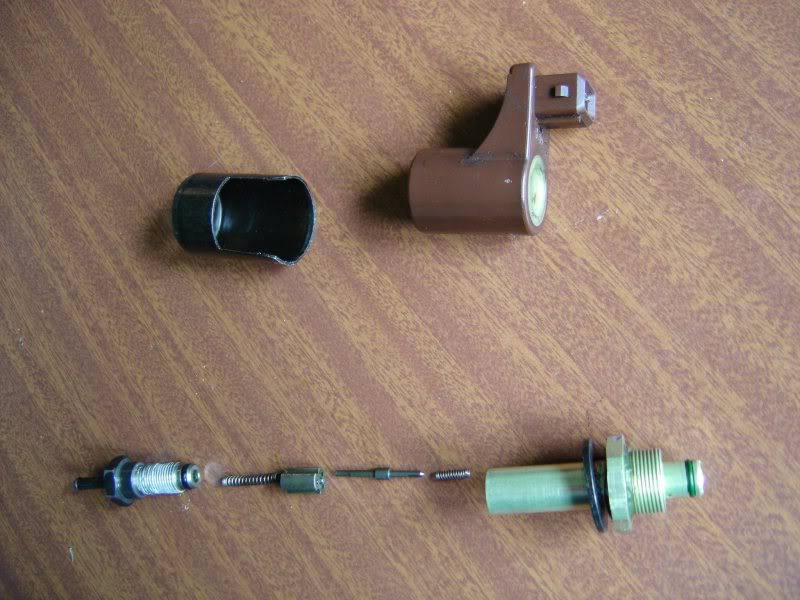One of which concerns the rear electrovalve. The problem I have is that if I open a door or the hatch without the engine running the rear will quickly sink, i.e. when the valve is activated into soft mode any pressure in the rear system is quickly lost and the rear collapses. My question is, with the valve in soft mode and the engine not running could an internal leak in the electrovalve cause this to happen?
Electrovalve internals
-
Stempy
- Posts: 1626
- Joined: 26 Feb 2004, 23:21
Electrovalve internals
Just back from a thousand mile round trip to 'oop north' and glad to report that the Xant performed faultlessly ( well, apart from the faults I already knew about ) 
One of which concerns the rear electrovalve. The problem I have is that if I open a door or the hatch without the engine running the rear will quickly sink, i.e. when the valve is activated into soft mode any pressure in the rear system is quickly lost and the rear collapses. My question is, with the valve in soft mode and the engine not running could an internal leak in the electrovalve cause this to happen?
One of which concerns the rear electrovalve. The problem I have is that if I open a door or the hatch without the engine running the rear will quickly sink, i.e. when the valve is activated into soft mode any pressure in the rear system is quickly lost and the rear collapses. My question is, with the valve in soft mode and the engine not running could an internal leak in the electrovalve cause this to happen?
It infuriates me to be wrong when I know I'm right
Lexia ponce
http://perception.dyndns.biz/~avengineering/index.htm
Lexia ponce
http://perception.dyndns.biz/~avengineering/index.htm
-
Chris570

- (Donor 2020)
- Posts: 1473
- Joined: 12 Dec 2009, 14:10
- x 34
ah ha, i wasnt the only one!!!!
this happened on the front of mine, i suspected either a ruptured centre sphere or as you suggest a heavy internal leak of the valve causing it to lose all the pressure behind the valve so when actuated all the pressure rushes to equalise dropping the car down an inch or so.....
mine had a sticking height corrector so i took it to martin at pleadies (sp) to have the work done and while it was there ALL sphere pressures were checked and all came up good. As we were running out of time he reassembled it with a new height corrector and since then all has been well...
so if you have a sticky height corrector it might possibly be the same cause.
I can't explain hydraulically why this would happen but it certainly cured mine (4000 miles now and all is well)
this happened on the front of mine, i suspected either a ruptured centre sphere or as you suggest a heavy internal leak of the valve causing it to lose all the pressure behind the valve so when actuated all the pressure rushes to equalise dropping the car down an inch or so.....
mine had a sticking height corrector so i took it to martin at pleadies (sp) to have the work done and while it was there ALL sphere pressures were checked and all came up good. As we were running out of time he reassembled it with a new height corrector and since then all has been well...
so if you have a sticky height corrector it might possibly be the same cause.
I can't explain hydraulically why this would happen but it certainly cured mine (4000 miles now and all is well)
2006 C5 HDi 170
1998 Xantia Activa S1
1971 D Special
2018 Renault Zoe,
1998 Xantia Activa S1
1971 D Special
2018 Renault Zoe,
A 1/3 of Team WFA 'Clarkson'CitroJim wrote: I'm a pink fairy
-
KevMayer
- Posts: 1051
- Joined: 12 Sep 2003, 22:01
- x 2
The electrovalve will pass LHM if the small spring is weak.
In the picture below the small spring is on the right of the central spindle. This small spring becomes compressed and weak but, the valve needs it to push the spindle forwards in soft mode to press the sharp end of the spindle into the LHM return port.
What you need to do is open up the electrovalve and stretch the small spring. Or, find another suitable spring.

In the picture below the small spring is on the right of the central spindle. This small spring becomes compressed and weak but, the valve needs it to push the spindle forwards in soft mode to press the sharp end of the spindle into the LHM return port.
What you need to do is open up the electrovalve and stretch the small spring. Or, find another suitable spring.

Cheers, Kev
02 plate C5 2.2 Hdi Exclusive SE (now 170k miles 03/21).
Used to have:- Xantia 1.9 TurboD SX. 1996 Blue & 1998 Silver Activa. + 1992 BX TZD Turbo.
02 plate C5 2.2 Hdi Exclusive SE (now 170k miles 03/21).
Used to have:- Xantia 1.9 TurboD SX. 1996 Blue & 1998 Silver Activa. + 1992 BX TZD Turbo.
-
Peter.N.
- Moderating Team
- Posts: 11635
- Joined: 02 Apr 2005, 16:11
- x 1222
-
xantia_v6
- Forum Admin Team
- Posts: 10084
- Joined: 09 Nov 2005, 22:03
- x 1112
-
Stempy
- Posts: 1626
- Joined: 26 Feb 2004, 23:21
Well that could explain something as the one causing the problem is actually from an XM.
It infuriates me to be wrong when I know I'm right
Lexia ponce
http://perception.dyndns.biz/~avengineering/index.htm
Lexia ponce
http://perception.dyndns.biz/~avengineering/index.htm
-
Peter.N.
- Moderating Team
- Posts: 11635
- Joined: 02 Apr 2005, 16:11
- x 1222
-
Dommo

- (Donor 2025)
- Posts: 1210
- Joined: 11 Apr 2009, 09:43
- x 19
-
KevMayer
- Posts: 1051
- Joined: 12 Sep 2003, 22:01
- x 2
The Activa and centre electrovalves work in opposite ways.
The centre valves are energised to connect the centre sphere to the system for soft mode and de energised to isolate it to stiffen.
The Activa sphere is connected when the valve is de energised and isolated when the valve is energised.
The activa sphere is normally connected to soften the effective anti roll bar. It is isolated by switching the electrovalve to isolate the Activa sphere when cornering and so stiffening the roll bar.
The centre valves are energised to connect the centre sphere to the system for soft mode and de energised to isolate it to stiffen.
The Activa sphere is connected when the valve is de energised and isolated when the valve is energised.
The activa sphere is normally connected to soften the effective anti roll bar. It is isolated by switching the electrovalve to isolate the Activa sphere when cornering and so stiffening the roll bar.
Cheers, Kev
02 plate C5 2.2 Hdi Exclusive SE (now 170k miles 03/21).
Used to have:- Xantia 1.9 TurboD SX. 1996 Blue & 1998 Silver Activa. + 1992 BX TZD Turbo.
02 plate C5 2.2 Hdi Exclusive SE (now 170k miles 03/21).
Used to have:- Xantia 1.9 TurboD SX. 1996 Blue & 1998 Silver Activa. + 1992 BX TZD Turbo.
-
Dommo

- (Donor 2025)
- Posts: 1210
- Joined: 11 Apr 2009, 09:43
- x 19
Yeah I understood how it works from when I took mine apart. My activa electrovalve was an XM electrovalve, but with the sprung parts from the Activa electrovalve, however as far as I could tell they were almost identical!KevMayer wrote:The Activa and centre electrovalves work in opposite ways.
The centre valves are energised to connect the centre sphere to the system for soft mode and de energised to isolate it to stiffen.
The Activa sphere is connected when the valve is de energised and isolated when the valve is energised.
The activa sphere is normally connected to soften the effective anti roll bar. It is isolated by switching the electrovalve to isolate the Activa sphere when cornering and so stiffening the roll bar.
-
Stempy
- Posts: 1626
- Joined: 26 Feb 2004, 23:21
So, if I've got this right, the big spring keeps the valve closed when it is in hard mode and not activated and the small spring keeps the valve open when in soft mode and the valve is activated, the open spring is small as it has the assistance of the field coil to keep it open.[/i]KevMayer wrote:The electrovalve will pass LHM if the small spring is weak.
In the picture below the small spring is on the right of the central spindle. This small spring becomes compressed and weak but, the valve needs it to push the spindle forwards in soft mode to press the sharp end of the spindle into the LHM return port.
What you need to do is open up the electrovalve and stretch the small spring. Or, find another suitable spring.
It infuriates me to be wrong when I know I'm right
Lexia ponce
http://perception.dyndns.biz/~avengineering/index.htm
Lexia ponce
http://perception.dyndns.biz/~avengineering/index.htm
-
OnlineCitroJim

- A very naughty boy
- Posts: 53209
- Joined: 30 Apr 2005, 23:33
- x 7395
Yes, that is absolutely correct Stempy, in soft (open) the valve is kept open by a combination of the solenoid and hydraulic pressure.
If the pressure is low, the solenoid on its own is not enough to operate it, hence if the main pressure is low, the valve might not operate properly.
You can hear this in action. With good hydraulic pressure the click at the beginning and end of soft mode is very strong and loud. If you operate the valves with no hydraulic pressure the clicks are soft and quiet.
If the pressure is low, the solenoid on its own is not enough to operate it, hence if the main pressure is low, the valve might not operate properly.
You can hear this in action. With good hydraulic pressure the click at the beginning and end of soft mode is very strong and loud. If you operate the valves with no hydraulic pressure the clicks are soft and quiet.
Jim
Runner, cyclist, duathlete, Citroen AX fan and the CCC Citroenian 'From A to Z' Columnist...
Runner, cyclist, duathlete, Citroen AX fan and the CCC Citroenian 'From A to Z' Columnist...
-
KevMayer
- Posts: 1051
- Joined: 12 Sep 2003, 22:01
- x 2
The small spring, I'm pretty sure, is important to push the spindle forward in soft mode so it seats in the leak off port to stop LHM leaving via this port.
I've found that if you give the small spring a stretch, so its about 50% longer when relaxed, that this improves the plugging action.
I've found that if you give the small spring a stretch, so its about 50% longer when relaxed, that this improves the plugging action.
Cheers, Kev
02 plate C5 2.2 Hdi Exclusive SE (now 170k miles 03/21).
Used to have:- Xantia 1.9 TurboD SX. 1996 Blue & 1998 Silver Activa. + 1992 BX TZD Turbo.
02 plate C5 2.2 Hdi Exclusive SE (now 170k miles 03/21).
Used to have:- Xantia 1.9 TurboD SX. 1996 Blue & 1998 Silver Activa. + 1992 BX TZD Turbo.
